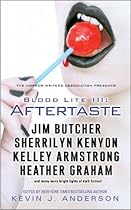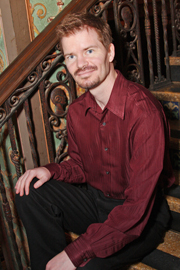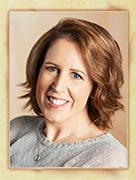The third book in the hilarious and horrifying national bestselling anthology series from the Horror Writers Association—a frightfest of sidesplitting stories from such New York Times bestselling authors as Jim Butcher, Sherrilyn Kenyon, Heather Graham, L.A. Banks, Kelley Armstrong, and many more!
Horror fiction explores the dark side of human nature, often pushing the limits of violence, graphic gore, and extreme emotions. Blood Lite III: Aftertaste puts the fun back into dark fiction, featuring a wide range of humorous and highly entertaining horror-filled tales.
After my interview with Kevin J. Anderson, the Blood Lite editor, I tapped a bunch of the authors to talk about why humor is so important in the horror genre, and what inspired their horrifically hilarious tales. This is part one of four.
“[W]ith the popularity of shows and movies such as The Walking Dead, True Blood, Twilight, and Buffy the Vampire Slayer, audiences have demonstrated their love for [horror]—especially accompanied with a dose of humor to tone down the terror.”
This above quote is from the synopsis of Blood Lite: Aftertaste. Why do you think humor is so important in a horror story?
- Lisa Morton: Horror and humor go together like blood and band-aids—one helps to relieve the other.
- JG Faherty: First off, I don’t think humor is ‘important’ in a horror story per say; it’s just that horror with a touch of humor is a very popular subset of the horror genre, just as it is with any other genre. Romantic comedies do better than dramatic romance movies; action movies with a shot of the funnies often do better than hard action. People like to laugh—it’s a universal. Not everyone enjoys being scared, or having a good cry, or sitting through impossible car chases. But show me someone who hates to laugh and I’ll show you a Vulcan. Or a serial killer. When it comes to horror, I think there is a second factor as well: it takes the edge off the scares. Instead of having x-number of hours of intense fear, you have spurts of it broken up by the laughs. It is a tension release, and you actually look forward to it coming. The horror is more palatable when you know it’s only temporary.
- Mike Baron: Any good story has an element of humor in it. When we confront the inexplicable or the terrifying humor serves as an escape valve to help us handle the situation.
- Jeff Ryan: There are a million ways to tell a dramatic story and make it work. If you’re reading a funny story and you don’t chuckle, it doesn’t work. Ditto for scary stories. And there’s an overlap in emotions, since fright makes you tense, and laughter releases the tension. Really, comedy and horror are opposite sides of the same coin. Mel Brooks said it best: “Tragedy is when I cut my finger. Comedy is when you fall into an open manhole and die.”
- David Sakmyster: Simply put, it provides the necessary spark of humanity in the face of the inhuman, and reminds us that even when all seems bleakest, sometimes a little chuckle is all it takes to prove that IT (whatever horror ‘it’ is)—while it may kill us in horrifying ways—will never truly get the best of us.
- John Alfred Taylor: It isn’t always. But in entertainments
like those cited the humor reminds the audience that horror is
entertainment, fun with tropes, so to speak. Hoary old tropes that
deserve mockery. Zombies are boring, and vampires metabolically
unconvincing. But one can have knowing fun with the tropes, as in
Scream or The Rocky Horror Show, so you can have your horror cake and
eat it too—simultaneously be scared and laugh at it.
But humor does other things for horror. For instance it can damp down the pressure just enough. Think of watching a horror movie in a crowded theatre—the tension raised instant by instant till a young man somewhere can’t stand it and bursts into braying laughter. A little sprinkle of humor at the right moment might prevent that. And sometimes humor and horror are inseparable: in L. P. Hartley’s “The Traveling Grave” the protagonist’s misunderstanding of what his host collects (baby carriages instead of coffins) is part of the fun. Or in stories by M. R, James the humor helps construct the comfortable tissue of normality that the revenant rips through: as examples see the choleric Colonel Wilson in “O Whistle, and I’ll Come to You” or the estate bailiff spouting malapropisms in “Mr. Humphreys and His Inheritance.”

- Adrian Ludens: My brother-in-law pointed out that whenever we go through a Halloween spook house, I’m the one who’s always laughing. I think there’s something fun about being scared while knowing you are safe. With a humorous horror story, I think the author is saying to the reader: ‘Hey, come with me on this crazy adventure... you’re going to experience some things that are scary or even awful, but don’t worry; you’ll have fun and maybe even laugh about it.’
- Chris Abbey: Horror is a way to distance oneself from the things of which we are afraid. A second way to distance is to laugh at them. In “Abbot and Costello Meet Frankenstein,” for instance, we laughed at Costello partly because he was so much more frightened of these monsters than we like to think we’d be. Wes Craven understands the absurdity of the monster within.
- Christopher Golden: A good laugh is cathartic, and so is a good scare. Put the two together, and it’s even better. Both humor and horror bring us to a physically agitated state. They give us a rush. And when we start coming down from that, it’s exhilarating.
- Jeff Strand: Often I like to use humor to soften the reader for the kill. Make them laugh, lower their defenses, and then hit them with something much more horrific than they were expecting! Humor can also be used to create empathy for a character—we like people who make us laugh—and it can also make a story more realistic because, after all, real life is funny!

- Kelley Armstrong: I don't think it's critical for horror to have humor, but it does provide tension relief, which can make it a more emotionally satisfying read. As the sense of dread mounts, those little "oases" of humor give the reader breathing space, which can give the next shot of horror an even bigger jolt.
Part 2 coming next week!
Related Articles
- Kevin J. Anderson interview
BLOOD LITE: AFTERTASTE AUTHORS
Lisa Morton has written six movies, four books of non-fiction, two novellas, one novel, and somewhere around fifty short stories. She’s a three-time Stoker Award winner, a recipient of the Black Quill Award, and her cats think she’s awesome. She lives online at www.lisamorton.com. | |||
JG Faherty is an Active Member in the Horror Writers Association. His first novel, CARNIVAL OF FEAR, was published in 2010. His second book, GHOSTS OF CORONADO BAY, was released in 2011, and his third will be coming out in late 2011 as well. His other credits include Cemetery Dance, Shroud Magazine, and several major anthologies, among them Appalachian Winter Hauntings, Legends of the Mountain State 3 & 4, Bound for Evil, Dark Territories, Horror Library IV, and the upcoming Beast Within 2 and Best New Zombie Tales 3. A freelance writer with over 15 years of experience, his varied background includes working as a laboratory manager, accident scene photographer, zoo keeper, research scientist, and resume writer. When it comes to humor, he enjoys teaching bad words to small children, watching Married with Children, wearing ugly Hawaiian shirts, and trading insults with his friends. | |||
Mike Baron broke into comics with Nexus, his groundbreaking science fiction title co-created with illustrator Steve Rude. He has written for Creem, The Boston Globe, Isthmus, AARP Magazine, Oui, Madison, Fusion, Poudre Magazine, Argosy and many others. Nexus is currently being published in hardcover by Dark Horse. Baron has won two Eisners and an Inkpot for his work on Nexus, now being published in five languages including French, Italian, Portuguese, and Spanish. Baron’s revamp of DC’s The Flash continues to garner great reviews. Marvel recently published two collections of Baron’s Work, The Essential Punisher Vol. II and The Essential Punisher Vol. III. A prolific creator, Baron is at least partly responsible for The Badger, Spyke, Feud, The Hook, and The Architect. The latter is available as a graphic novel from Big Head Press. www.bloodyredbaron.net | |||
| Jeff Ryan is the author of Super Mario: How Nintendo Conquered America. He first got interested in mixing comedy and horror when a clown murdered his dog. twitter.com/#!/dailymario | supermariobook.com | ||
David Sakmyster is an award-winning author and screenwriter whose short stories have appeared in The Writers of the Future Anthology, ChiZine, Horrorworld, Black Static, Talebones, Abyss & Apex and others. THE PHAROS OBJECTIVE and forthcoming THE MONGOL OBJECTIVE are the first two novels in a series about psychic archaeologists. He’s also written the horror novel CRESCENT LAKE, and the historical fiction epic, SILVER AND GOLD. You can step into his mind at www.sakmyster.com. | |||
John Alfred Taylor is a retired professor of English in Southwest Pennsylvania, and has been writing science fiction and horror for years. He has been published in GALAXY, GALILEO, GRUE, OCEANS OF THE MIND, and ASIMOV’S, and had stories reprinted in YEAR’S BEST HORROR STORIES. A collection of Taylor’s horror stories, HELL IS MURKY, is available from Ash-Tree Press. | |||
Adrian Ludens is a radio personality and program director for a classic rock station in the Black Hills of South Dakota. His fiction has appeared in Morpheus Tales, Alfred Hitchcock’s Mystery Magazine and a number of small press horror anthologies. Recent appearances include stories in Made You Flinch 2: Two For Flinching (edited by Bill Tucker, Library of Horror Press) and in Zombie Kong (edited by James Roy Daley, Books of the Dead Press). Adrian first short story collection is available on Amazon. | |||
| Chris Abbey was created in the 60s during a bad thunderstorm and someone’s bad trip. His hobbies are grave-robbing, sewer-lurking, and macrame. He is considering a job offer from a major magazine, and will consider it further if the offer ever actually happens. The picture is a still from a YouTube video in which he discusses how to tell a joke (true). | |||
| Christopher Golden is an award-winning, bestselling author of novels for adults and teens, as well as a comic book writer, screenwriter, and editor. He was born and raised in Massachusetts, where he still lives with his family, and his original novels have been published in more than fourteen languages in countries around the world. His is not funny. Please visit him at www.christophergolden.com | |||
Jeff Strand: Stories by Jeff Strand have appeared in all three BLOOD LITE volumes. He’s written a bunch of novels, including stuff like WOLF HUNT and FANGBOY, and he’ll give you a great big hug if you visit his website at www.jeffstrand.com. | |||
Kelley Armstrong: Kelley Armstrong has been telling stories since before she could write. Her earliest written efforts were disastrous. If asked for a story about girls and dolls, hers would invariably feature undead girls and evil dolls, much to her teachers' dismay. All efforts to make her produce "normal" stories failed. Today, she continues to spin tales of ghosts and demons and werewolves, while safely locked away in her basement writing dungeon. She's the author of the "Women of the Otherworld" paranormal suspense series, "Darkest Powers" young adult urban fantasy trilogy, and Nadia Stafford crime series. She lives in southwestern Ontario with her husband, kids and far too many pets. www.KelleyArmstrong.com |













No comments:
Post a Comment